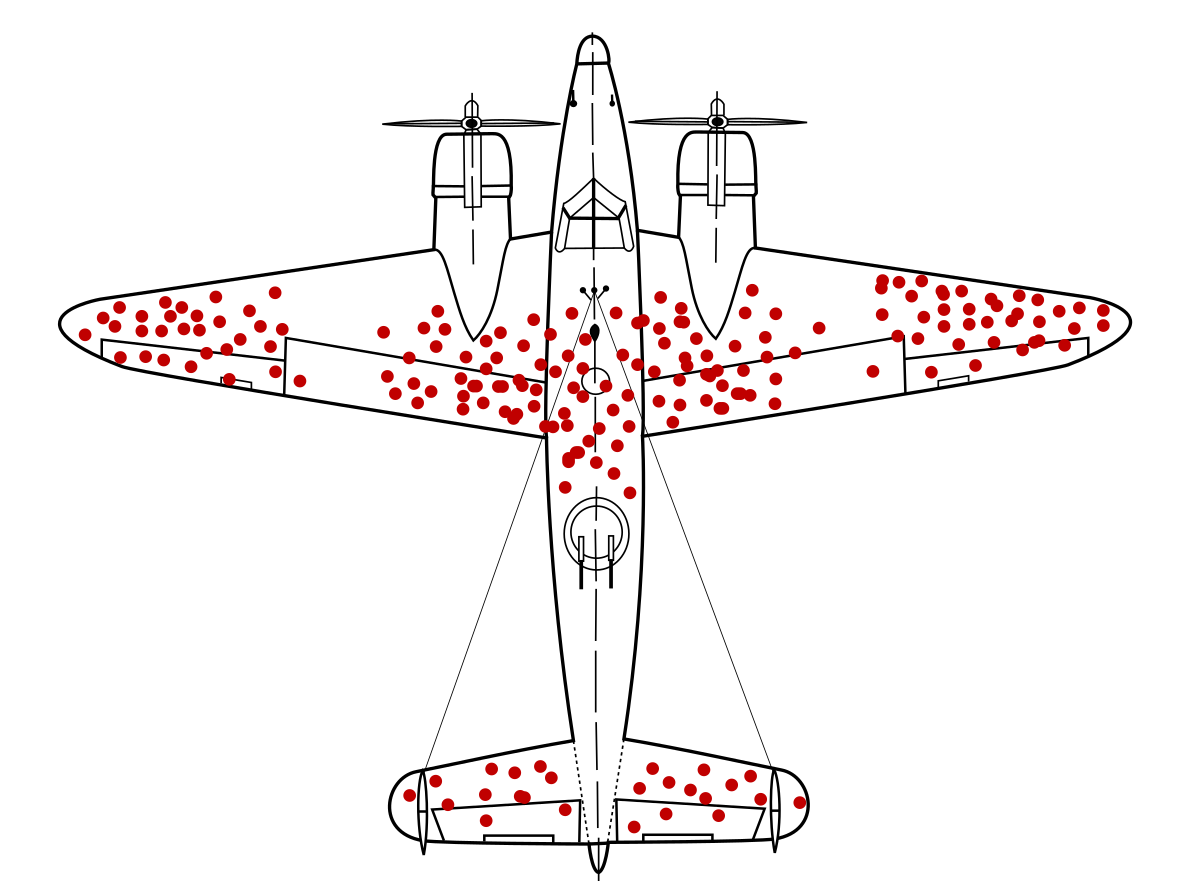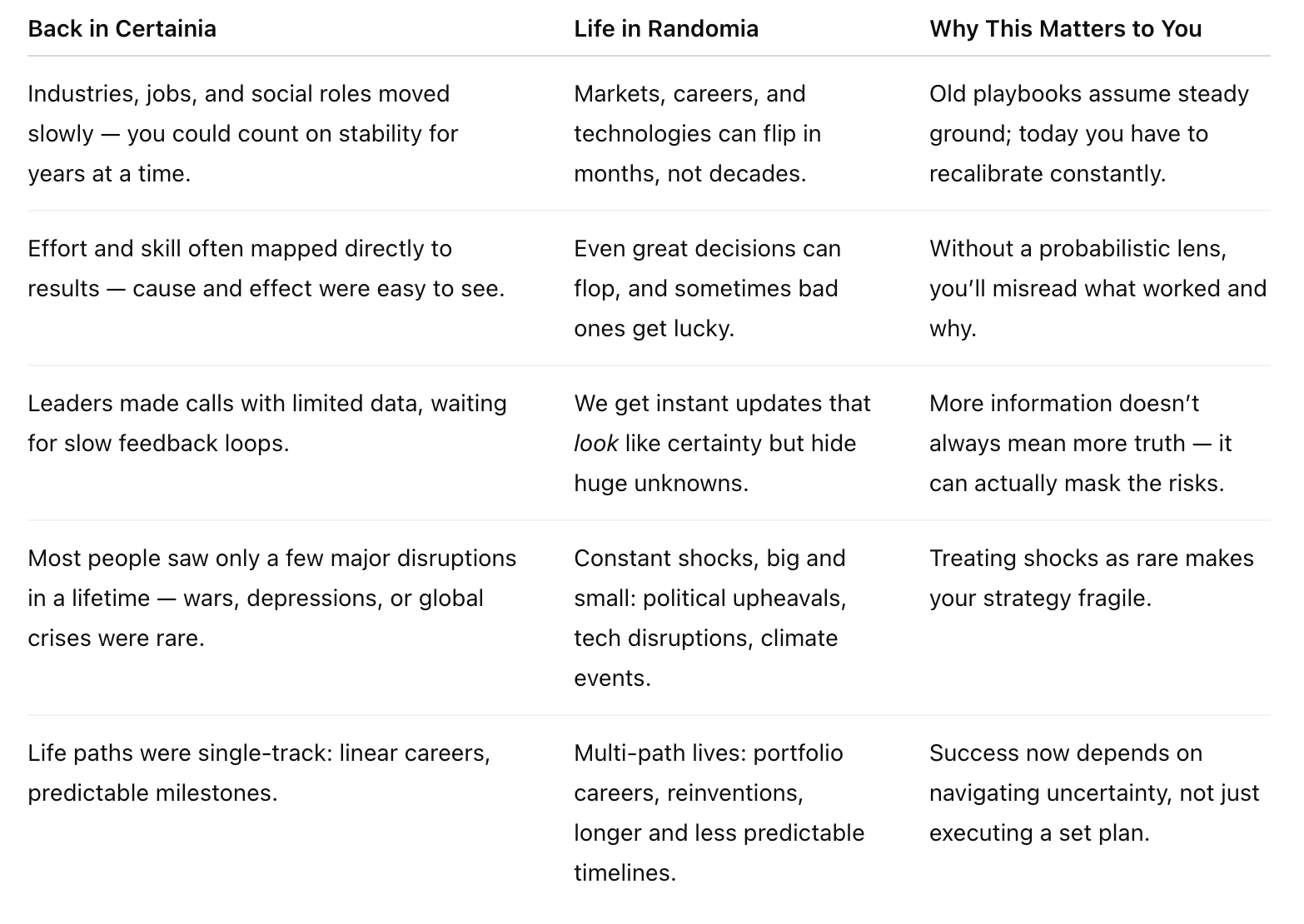P8: Probabilities - Think in Probabilities, Not Absolutes
"If you do not understand elementary probability, then you go through life like a one-legged man in an ass-kicking contest." – Charlie Munger
- The Problem: Many of us grew up in a world like Certainia. It’s a place where answers were either right or wrong, outcomes felt predictable, and confidence meant pretending you always knew for sure. But the world we actually live in is more like Randomia, where events unfold unpredictably, unexpected “black swan” events are the norm, and certainty is nothing but an illusion. When we cling to absolutes, we overlook risks, miss hidden threats, and create rigid plans that crumble under pressure.
- The Shift: Move beyond binary “yes or no” thinking and start treating beliefs as bets. Thinking in probabilities means asking questions like, “How likely is this?” and “What’s my plan if I’m wrong?” instead of just, “Will this happen?” It’s about aligning your confidence with the odds, preparing for multiple scenarios, and staying flexible enough to adapt when reality shifts.
- The Payoff: By planning around probabilities rather than certainties, you’ll become more agile, resilient, and ready for anything. You’ll sidestep major surprises, capitalize on opportunities that others overlook, and thrive in the chaos of uncertainty, while others remain stuck waiting for clarity that will never arrive.
Pascal's Wager & Wald's Bomber
Two vastly different tales—one from a 17th-century mathematician and one from the turmoil of World War II—highlight the same lesson: when certainty is out of reach, probabilities provide the best guidance.
Imagine staring uncertainty in the face, and realizing it was never about uncertainty at all. It's all about risk, reward, and the stakes.
That’s what Blaise Pascal did in the 17th century. He didn’t just see belief in God as a theological question. In fact, he did something radical. He reframed it as a bet.
If you believe that God exists, then the payoff is enormous: eternal life.
If God doesn't exist, then your cost is small: a bit of time for worship, a few religious habits, and giving up a few earthly pleasures.
But here's the crunch. If you do not believe, and God does exist - then you've lost everything.
Pascal wasn’t chasing proof. He was weighing different outcomes.
Pascal wasn't asking whether God is real. This is what he was asking:
Given the odds and stakes, which choice has the best payoff?
Fast forward three centuries and the same mindset would save lives.
During World War II, Allied statisticians studied bomber planes riddled with bullet holes. Naturally, they thought, “We need to reinforce those areas of the plane that are getting hit the most.”
Logical, right?
Wrong.
Statistician Abraham Wald saw what others were missing.
These planes had survived, which meant that the bullet holes didn’t mark weakness. They marked resilience.
The real danger wasn't where the bullets had it. It was the untouched areas.
Wald noticed that if the planes were hit in the cockpits, engines, or fuel tanks - they didn't come back.

Wald had flipped the perspective. It wasn’t just about what was visible, but what was missing. What mattered wasn’t simply what was likely, but what was at risk.
That’s probabilistic thinking in action.
It wasn't just about what would most likely happen. It's what matters most if it does.
Pascal’s wager and Wald’s bomber problem give us a roadmap for living in the gray zone of uncertainty.
In this gray zone, it's not about guaranteed outcomes, but asking the right questions.
- What’s the upside if I’m right?
- What’s the cost if I’m wrong?
- And most importantly, what am I not seeing?
If you want to thrive in a world full of unknowns, stop looking for certainty. Learn to bet like the stakes matter.
The Blind Spot We All Share
Picture this: A CEO spends months perfecting a product launch strategy. The first week’s sales soar past projections, and she assumes her strategy was flawless. Fast forward six months, a similar approach flops with a new product, leaving her questioning what went wrong.
Or think about a friend who proudly says, “We’ve been inseparable for 30 years. Nothing will change that.” Yet, one misunderstanding causes a rift that never heals.
What’s the common thread here? It’s not a lack of effort, intent, or skill.
The issue is a blind spot we all share. Humans are wired to see the world as more predictable and controllable than it really is, even when reality tells us otherwise.
Why Does This Blind Spot Exist?
1. Our Brains Love Stories
We’re natural storytellers. Our minds create narratives to explain events, connecting dots and constructing a “logical” chain of cause and effect. This gives us the illusion that events are inevitable—even when luck or randomness played a huge role.
Example: A startup raises millions, and people attribute the success to a “visionary founder.” But what about the other hundred startups with equally visionary founders that didn’t make it? This narrative bias comforts us by making life feel predictable but blinds us to the role of probability.
2. We Confuse Skill with Results
When things go well, we pat ourselves on the back. When things go poorly, we blame ourselves. But in a nonlinear world, outcomes are only partially tied to skill.
Example: A trader might take a reckless gamble, get lucky, and assume they’re talented. Meanwhile, a cautious investor could lose money during a downturn and think they’re incompetent. Without focusing on probabilities, we often misinterpret life’s lessons.
3. We Seek Certainty, Not Truth
The human brain craves certainty. It’s easier to feel safe and confident with black-and-white answers than with probabilities and nuances.
Example: A manager might say, “This new product will succeed,” rather than, “We’re 70% confident this will work.” Why? Because absolute statements feel more comforting, even if they’re less accurate.
4. We're Not Good at Imagining Alternatives
Once we know how something ends, we trick ourselves into believing “it was always going to happen this way.” This is hindsight bias in action. It blinds us to the fact that things could have turned out differently.
Example: Someone reflecting on a breakup may say, “The signs were obvious—I should have seen it coming.” But before the breakup, they likely couldn’t have predicted it with certainty.
The Ultimate Cost – And the First Step to Clarity
We often mistake a world of probabilities for one of certainty. We make plans, build careers, and shape identities based on the illusion of control. But when chance inevitably disrupts those plans, we label it as failure.
The key shift is to stop asking, “Was I right?” and instead ask, “Given the odds, did I make a smart choice?”
Making this change isn’t just wise; it’s a necessary mindset for navigating today’s unpredictable world.
Why This Shift Matters Now
The world used to feel like a well-paved road: mostly steady, with the occasional bump along the way.
You could map out a career, craft a business strategy, or invest with confidence, trusting that conditions would stay predictable long enough for your plans to succeed.
That road doesn’t exist anymore.
We’ve moved from a predictable world with occasional surprises to an unpredictable one with brief moments of stability.
Think about it:
- Professionals who built "foolproof" business plans in 2019 saw them derailed by the pandemic.
- Investors who trusted “safe” institutions like SVB in 2022 watched their funds vanish.
- Workers who dedicated years mastering their craft are now seeing AI do in months what once took decades.
Five Forces That Demand Probabilistic Thinking
This isn’t just a trend. These forces have fundamentally changed how decisions are made, making probabilistic thinking a must-have skill in today’s chaotic world.
1. The Speed of Change
Technology, markets, and consumer behavior now evolve faster than laws, institutions, or even personal career plans. By the time you feel certain about something, the situation may already be different.
Example: A marketing strategy focused on Facebook ads can collapse overnight due to a single algorithm update. Linear, cause-and-effect thinking simply can’t keep pace with exponential change.
2. Interconnected Fragility
We live in tightly connected systems where small, random events snowball into massive disruptions.
Example: One ship blocked the Suez Canal, delaying billions in trade. These "black swan" events are happening more often than standard mental models account for.
3. More Data, Less Certainty
We’re swimming in data, but more numbers don’t always equal more clarity. Metrics create the illusion of certainty while distracting from the complexity of real outcomes.
Example: Climate models agree on warming trends, but the exact speed and severity of impacts remain unclear. Overconfidence in data can be just as dangerous as ignoring it.
4. Longer Timelines, More Complexity
If you're likely to live to 90 or beyond, you’ll witness more market crashes, career pivots, and personal reinventions than past generations. The longer your timeline, the more random events will shape your path.
Example: A 25-year-old planning to retire from their current industry is placing a bet on odds stacked against them.
5. Bigger Risks, Bigger Consequences
Small misjudgments in probability can now create enormous consequences. Betting on the wrong path or sticking to fragile strategies can leave you exposed to catastrophic failure.
Example: Overleveraged companies built on the assumption that interest rates wouldn’t rise faced severe consequences when rates spiked.

Planning for Randomia, Not Certainia
We’ve entered a new reality, yet most of us continue to prepare as though we’re living in the old one. This gap between expectation and reality is where people lose opportunities, resources, and confidence.
That's why probabilistic thinking is more important than ever. It’s the mental framework built for a world where unpredictability isn’t the exception, but the norm.
When you learn to think in probabilities, you make decisions that are adaptable, resilient, and suited for today’s complex environment. Better choices mean better outcomes in the long run.
Why the Old Model Falls Short
There was a time when you could map out a plan, and the world would more or less play along. Careers often followed a predictable path for decades.
A business strategy could hold steady for five years without requiring a complete redesign. Even forecasts were close enough to the mark most of the time.
But that era is behind us.
Now, a product hailed as a “sure thing” in January can lose its relevance by August. A skill you’ve mastered today might be automated by next quarter. And what used to be rare, disruptive events now feel like the norm.
This new reality calls for more than just sharper answers. It requires an entirely different approach to how we think, decide, and plan.
Enter probabilistic thinking.
This isn’t about becoming vague or wishy-washy. It’s about making smarter decisions, developing flexible strategies, and aligning expectations with how the world really operates.
From One Path to Many Possibilities
Old Model: Develop a single plan based on an expected outcome.
New Mindset: Prepare for multiple possible futures.
Rigid plans break under the weight of shifting realities. Probabilistic thinkers hedge their bets by planning across a range of outcomes, ready to pivot when the unexpected happens.
From Certainty Bias to Adaptive Resilience
Old Model: Treat uncertainty as an obstacle.
New Mindset: See certainty as a limitation, not a strength.
When you rely on one fixed path, risks are underestimated, and systems become fragile. True resilience comes from being flexible and adapting when surprises hit.
From Specialist Knowledge to Everyday Use
Old Model: Leave probability to statisticians and casinos.
New Mindset: Make probability an accessible, everyday tool.
You already use probabilistic thinking when you say, “Probably” or “It depends.” The difference is making these gut feelings intentional and shaping them into actionable strategy.
From Hesitation to Confident Action
Old Model: Wait for perfect clarity before making a move.
New Mindset: Act with reasonable confidence, even if it’s just 51%.
Waiting for all the answers often means missing the opportunity. Those who leap with "good enough" information tend to learn faster and adapt sooner.
From Predictions to Preparation
Old Model: Expect probability to give exact outcomes.
New Mindset: Use probability to prepare for a range of scenarios.
This isn’t about saying, “This will happen,” but rather, “This is likely, and here’s how we’ll handle the alternatives.”
From Risk Avoidance to Smart Bets
Old Model: Use probability to steer away from risk.
New Mindset: Balance risk and reward intentionally.
Progress often requires calculated risks. The trick is to safeguard against severe downsides while staying bold enough to seize upside opportunities.
From Fixed Beliefs to Flexible Hypotheses
Old Model: Stick stubbornly to initial assumptions.
New Mindset: Treat beliefs like working theories that evolve with new information.
The best thinkers continually update their perspectives as data changes. Staying rigid isn’t strength; staying adaptable is.
From Blind Instinct to Conscious Calibration
Old Model: Separate intuition from reason.
New Mindset: Pair intuition with deliberate analysis.
Your gut feelings are an informal form of probability. Instead of dismissing them, fine-tune them with clear odds-based thinking.
From Being "Right" to Making Better Decisions
Old Model: Success equals always being correct.
New Mindset: Success equals focusing on the quality of your decisions.
Even smart strategies can have bad outcomes. Over time, however, consistent processes win out over lucky breaks and bad bets.
From Absolute Confidence to Tactical Calibration
Old Model: Confidence means total certainty.
New Mindset: Confidence means accurate estimations.
Exceptional leaders talk in probabilities, not guarantees, and update their beliefs to match new realities.
From Planning for the Average to Preparing for Extremes
Old Model: Focus on the most likely scenario.
New Mindset: Build systems that can weather rare, high-impact events.
Breakthroughs and breakdowns rarely happen in the middle of the bell curve. They’re typically at the edges, where preparation often falters.
The Bottom Line
Most decision-making is still wired for “Certainia”—a world where one plan, one path, and one perfect answer are enough. But we now live in “Randomia,” where those who thrive are the ones who make better bets, adapt quickly, and prepare for a future full of unknowns.
Next up, we’ll explore why humans struggle with probabilistic thinking and how to turn this challenge into a powerful asset.
The History of Probabilistic Thinking
From Myth to Measurement
For most of human history, life was uncertain by default. Crops failed without warning. Storms sank ships. Disease swept through villages without explanation. People didn’t pretend to control these forces — they told stories about gods, fate, or luck to make sense of chaos.
Then, in the 1600s, an unlucky gambler changed everything.
The Gambler and the Mathematician — French nobleman Chevalier de Méré had a flair for velvet coats, long nights, and high-stakes dice games. He kept losing on what felt like a winning bet. Convinced fate was toying with him, he turned to mathematician Blaise Pascal. Pascal looped in Pierre de Fermat, and over a series of letters, the two cracked the puzzle. In doing so, they birthed probability theory — the first time randomness was treated not as divine whim, but as something measurable and actionable.
From Calculation to Complacency
Over the next centuries, probability thinking spread fast. Merchants used it to price cargo insurance. Actuaries used it to calculate pensions. Engineers used it to build bridges with safety margins. We’d gone from accepting uncertainty to quantifying it — and reaping the benefits.
But in the 20th century, something shifted.
The Weather Prophet — Early weather forecasts spoke in odds: “40% chance of rain.” People understood that as, “It might rain, so bring a coat.” But as forecasting improved, “it will rain” replaced “it might,” and we quietly outsourced probabilistic thinking to experts. The nuance faded from everyday decision-making.
The Golden Age of Certainia
After WWII, much of the West enjoyed a remarkably stable life path: school → job → house → pension → retirement. Advertisements promised “a home for life” and companies bragged about 30-year careers. Black swan events felt rare. The “average case” was safe enough. Probability became a specialist’s tool; ordinary people planned for one expected future and called it wisdom.
Back to Randomia
Then the world sped up. Globalization, technology, and hyper-connected systems pulled us back into high-variance terrain. Disruptions became constant. The median outcome stopped being a safe bet. But culturally, we were still carrying a mid-century certainty bias — still packing for Certainia while living in Randomia.
The irony: we haven’t lost the ability to think probabilistically. We simply forgot — right when we need it most.
Why Our Brains Resist Probabilities
The Comfort of Certainty
Imagine you're out on a long hike. The sky starts to darken, the wind picks up, and you see a 30% chance of rain on your weather app.
Do you grab your rain jacket, or do you dismiss it thinking, “It probably won’t rain”?
Most of us simplify that 30% forecast into something binary. Either, “Yes, it will rain,” or, “No, it won’t.” Why? Because holding onto that gray area—that sense of “it might or might not”—just feels uncomfortable.
Now think about a team meeting. One leader confidently says, “I’m certain this campaign will work.” Another says, “There’s a 70% chance it’ll succeed, and here’s how we’re preparing for the 30%.”
Which one gets the buy-in?
Chances are, it’s the first leader—even though the second is being more strategic.
Our discomfort with probabilities isn’t about a lack of math skills. It’s rooted in how our brains evolved to seek simplicity, speed, and certainty.
What's really at stake when you bet on the unknown?
Eight Reasons Probabilistic Thinking Feels Hard
1. We’re Built for Stories, Not Scenarios
We evolved to tell stories around campfires. We're storytelling creatures.
Stories help us make sense of the chaos, remember important lessons, and connect with others. They’re how we give order to life’s randomness.
But probabilities disrupt that narrative. A good story has a clear beginning, middle, and end. Probabilities, full of “what ifs” and “maybes,” take away those satisfying arcs.
This often leads us to oversimplify the situation, steering us away from a more accurate understanding of uncertainty.
2. We're Wired for Action, Not Hesitation
Picture this: You’re out in the wild, and you hear the grass rustling nearby. If you stop to calculate whether it’s a predator or the wind, it might be too late to act.
From an evolutionary perspective, immediate action—even if it’s wrong—is better for survival. This instinct explains why we trust decisiveness over nuanced uncertainty.
Statements like “I’m sure” feel more convincing than “I’m 65% sure,” even if the latter is more accurate.
Quick action screams leadership, while probabilistic thinking might seem slow and indecisive.
3. We Treat Probabilites Like Predictions
Probabilities don’t tell us what will happen; they tell us what could happen. Yet, when people hear “30% chance of rain,” they often translate it into “It will rain” or “It won’t.”
We struggle to hold onto the idea that multiple outcomes are possible. Instead of staying open to the range of probabilities, we flatten the uncertainty into a single all-or-nothing prediction.
4. We Fear Being Wrong More Than We Love Being Right
Probabilistic thinking forces us to face a hard truth: you can make the right call and still lose.
Our brains crave a world where success is purely a result of skill and effort. It builds our self-esteem and makes us feel in control.
Admitting that chance plays a role? That can feel like exposing a personal weakness. But the truth is, uncertainty is always part of the equation.
5. Certainty Unites Us, Especially in Groups
Throughout history, leaders who projected confidence inspired tribes, teams, and entire nations to act. Even when their certainty was misplaced, it motivated people to follow.
The same bias exists today. Audiences, teams, and voters still reward quick decisions and bold claims over cautious, nuanced ideas. Probability sounds careful, and care often gets misconstrued as a lack of confidence.
6. We’re Taught About “Right Answers,” Not Probability Ranges
From our earliest school days, we’re rewarded for being correct, not for analyzing uncertainty. Tests don’t ask, “What’s your confidence level?” They ask, “Is it right or wrong?”
Even in advanced education, statistics is often treated as abstract math instead of an essential tool for understanding the world. By the time adulthood rolls around, deterministic thinking is hardwired, and the ability to work with ranges feels foreign.
7. Culture Loves Certainty (and Certainty Sells)
Think about it. When was the last time you heard a politician, CEO, or media personality say, “There’s only a 60% chance this will happen”? Unlikely, right?
That’s because certainty performs. Statements like “I guarantee this will work” get applause and attention. Nuance? Subtlety? They don’t pack the same emotional punch. Over time, this “certainty theatre” conditions us to avoid probabilities and favor bold, absolute claims—even when they’re wrong.
8. Complexity Overloads Our Brains
Modern life is filled with constant complexity, and our brains aren’t built to process it all. When faced with too much information, we revert to mental shortcuts that make things simple but often inaccurate, including:
- Availability bias – Overestimating rare but vivid risks (like plane crashes) while underestimating common ones (like heart disease).
- Overconfidence bias – Believing we’re better at making predictions than we actually are.
- Anchoring – Latching onto an initial estimate, even when new evidence challenges it.
- Cognitive overload – Defaulting to the simplest answer because more effort feels overwhelming.
Rather than carefully weighing the odds, we act like gamblers, relying on gut feelings and hunches. But the cost of this simplicity often means missing the big picture.
The Real Challenge
Thinking in probabilities isn’t just a mental exercise—it’s an emotional one.
It requires you to balance competing outcomes, separate the decision-making process from the results, and accept that you’ll never have total control.
Our ancestors thrived by making quick, confident decisions. But today’s world rewards a different approach: thinking in ranges, preparing for a variety of outcomes, and staying flexible as reality evolves.
The good news? Probabilistic thinking is a skill you can develop. By building strong mental habits, you can train your brain to think this way naturally—even in high-pressure situations. Here’s what it takes to make that shift.
What This Principle Really Means
Probability Is a Tool for Planning, Not Predicting
Probability isn’t about guessing the future. It’s about being ready for it.
When you shift your mindset in this way, everything changes. The goal isn’t to guarantee success but to make smarter decisions grounded in likely outcomes and backed by adaptable strategies.
This isn’t abstract math for statisticians or gamblers. Probability is one of the most practical tools we have to handle uncertainty. It teaches us to replace rigid plans with flexible preparation, to approach life with contingencies for multiple outcomes rather than betting everything on a single one.
Five Key Lessons from Thinking in Probabilities
1. Stop Waiting for 100% Certainty Before Acting
You don’t need perfect clarity to move forward. Even a slight edge, like a 51% likelihood, is enough to get started, learn, and adjust. Waiting for all the answers often means you’ll miss the opportunity entirely.
2. Focus on Odds, Not Guarantees
Probability doesn’t claim, “This will definitely happen.”
Instead, it says, “Here’s what’s most likely. Prepare for different scenarios and have a fallback if the unexpected occurs.”
This isn’t fear-based thinking; it’s strategy.
3. Flexibility Creates Confidence
The most resourceful thinkers take bold actions, but they’re always prepared to adapt. They don’t put all their faith in a single plan. Instead, they stay agile, ready to adjust their course when new realities emerge.
4. Update Your Beliefs as You Go
Life is seldom linear. The probabilities of success shift as new information arises. Treat your assumptions as theories rather than fixed truths. Adjust your approach as the evidence evolves.
5. You Already Think in Probabilities
Any time you say “probably,” “maybe,” or “it depends,” you’re already using probabilistic thinking. It’s not about making life harder; it’s about making decisions sharper and more deliberate.
Why Probability Leads to Smarter Decisions
Thinking in probabilities doesn’t shield you from failure, but it does protect you from flawed decision-making. Over time, this can be the difference between a system that breaks under pressure and one that bends and adapts.
The future isn’t fixed; it’s a web of possibilities influenced by feedback, randomness, and ripple effects. Trying to chase absolute certainty often leads to wasted effort, blind spots, or unexpected failures.
“Certainty is the price you pay for ignoring the odds.”
If you feel that price in the form of missteps, wasted energy, or blindsided decisions, it’s time to trade old habits for smarter, data-informed ones.
The Mindset Shift That Matters Most
Stop chasing the “perfect plan” or the “right decision.” Instead, focus on these key strategies:
- Make smarter bets based on the most likely outcomes.
- Prepare yourself and your plans for multiple scenarios.
- Execute flexibly, knowing you can adjust as things unfold.
The people who thrive in uncertainty aren’t fortune-tellers. They’re strategic, adaptable thinkers.
Bottom line? Adaptability outperforms certainty every single time.
The Reality You Can't Ignore
Navigating the Shift Between Certainia and Randomia
For most of history, life operated in what we could call "Certainia" — a world where plans worked, cause and effect followed a straight path, and playing by the averages was a sound strategy.
It was a time when you planted seeds, waited for the rains, traded goods, and followed time-tested methods that your ancestors had sworn by. Predictability was the name of the game. Forecasts meant something. And success often came from sticking with stable, repeatable strategies.
But today, the game has changed.
Predictable systems still exist, so we visit Certainia from time to time. However, Randomia now steals the spotlight. It’s where you’ll find constant flux, interconnected systems, and a steady hum of uncertainty shaping our daily lives. Events come at you fast. Volatility is no longer the rare exception but the new norm.
Here’s the thing: living in Randomia isn’t the problem. The real risk is assuming you’re in Certainia when you're not, crafting strategies around stability in an environment that prizes adaptability. That’s when things crumble beneath you.
Why Randomia Has Become the Rule
Randomia isn’t just a world of more frequent change. It has its own set of rules, totally unlike those of Certainia.
Here are 10 forces driving this shift and highlighting why thinking linearly in Randomia can be a misstep:
1. Complex Systems Amplify Change
Small actions can snowball.
Remember the panic-buying during COVID-19? Fear of shortages created the very scarcity people hoped to avoid. Small shifts can ripple outward, turning minor disruptions into widespread impacts.
2. Interconnected Systems Make Failures Global
Local issues don't stay local anymore.
When a single ship blocked the Suez Canal, the ripple effects froze billions in global trade. Systems today are so tightly knit that a single domino can topple many.
3. Black Swan Events Are Now Regular Guests
"The rare" is no longer rare.
What do COVID-19, the 2008 financial crash, and Fukushima all have in common? They’re events we labeled as “outliers”—until they started happening uncomfortably often.
4. Extremes, Not Averages, Shape the Future
The tail wags the dog.
From billion-dollar tech unicorns to devastating climate disasters, the events that truly move the needle are at the edges, not the middle. If you're planning for "average," you're missing the point.
5. Tipping Points Hit Faster and Harder
From calm to chaos in the blink of an eye.
Whether it’s a tweet gone viral destroying a brand or a single regulatory decision sparking a geopolitical clash, the time between build-up and fallout has dramatically shrunk.
6. Historical Data Can Mislead
The past isn’t always a good predictor of the future.
When Silicon Valley Bank (SVB) bet on interest rates remaining stable, their reliance on past patterns blinded them to the new environment. The result? Collapse.
7. Environmental Shocks Aren’t Linear
Nature doesn’t play by straight lines.
A tiny increase in Arctic temperatures can destabilize global jet streams, bringing record heat waves in one region and unseasonal freezes in another. The rules of nature keep shifting.
8. Survivorship Bias Clouds Lessons
Success stories can be deceptive.
We love studying startups that hit billions in valuation, but what about the quiet 90% that never made it? Ignoring the failures means missing crucial insights.
9. Stability Leaves You Vulnerable
Certainty is comforting—but dangerous.
When times are calm, it’s easy to overestimate how stable things are. Then Randomia comes crashing in, and overconfidence turns into crisis management.
10. Scenario Planning Doesn’t Always Work
Planning for a handful of likely outcomes isn’t enough.
If you're only ready for the top few scenarios on your list, your strategy might already have weak spots. Preparing for deviation, not perfection, is the name of the game.
The Takeaway
Certainia rewards predictable strategies. But Randomia? It punishes them.
To succeed, we need a mindset shift:
- Move from certainty to probabilities.
- Ask, “How likely is this?” instead of, “Will this happen?”
- Always plan for backups and deviation.
The key is recognizing which land you’re operating in — Certainia or Randomia — and adapting accordingly. Agility and deliberate action become your most valuable tools.
The Truth No One Talks About
Have you ever been caught off guard by a sudden market shift, surprising results, or even unpredictable behavior from others? It’s not because you’re flawed.
The truth is, you’re likely playing by old rules that no longer align with the game.
We’re often taught to approach life in absolutes: success vs. failure, right vs. wrong, safe vs. risky. We equate confidence with competence, assuming that detailed planning will ensure predictable outcomes.
But here’s the key insight: certainty is a bias, not a superpower.
This bias creates dangerous habits:
- Mistaking decisiveness for intelligence, even when data is incomplete.
- Building overly rigid strategies based on one presumed outcome.
- Assuming the “safe” option is risk-free.
These illusions of control set us up to fail. Over time, they create systems that break under pressure instead of flexing to adapt.
And what drives this behavior?
Our deep-rooted attachment to the false comfort of feeling certain.
Here’s the real challenge we need to address. Every outcome in life hinges on two factors:
- The hand you’re dealt – including luck, timing, and randomness, all outside your control.
- How you play it – your ability to use skill, judgment, and adaptability, all within your control.
You only have direct influence over the second, and even then, luck can still tip the scales.
Once you internalize this, your mindset shifts. You stop judging decisions solely by their outcomes. Instead, you focus on strategies that account for multiple future scenarios, rather than betting big on just one.
You learn to build resilient systems that not only withstand unpredictability but also capitalize on opportunities that luck provides.
This approach reshapes how you think about success and risk. Flexibility becomes your strength. Adaptability becomes your competitive edge. And your ability to perceive uncertainty as part of the process—not a problem to solve—is what redefines how you play the game.
The future doesn't give a damn about your confidence. It only cares about how prepared you are when the curveballs land!
The Costs of Ignoring Probabilities
Remember the story of the WWII damaged bombers at the beginning of this post?
When damaged planes returned to base covered in bullet holes, the Allied statisticians almost made a fatal mistake.
They focused only on the planes that made it back and nearly ignored the silent evidence of those that didn’t survive. The real danger was where no bullet holes were found.
That’s the trap. It’s what happens when you trust what’s visible and ignore the risks lurking beneath the surface. And yes, we fall into this trap daily, trusting visible data while neglecting what's hidden.
Whether in business, careers, or personal decisions, relying on incomplete information and flawed assumptions can lead to failure when the unexpected strikes.
Six Ways Ignoring Probabilities Undermine Your Decisions
Failing to think in probabilities doesn’t just lead to poor choices. It erodes resilience, blocks opportunities, and leaves you vulnerable to failure you could have avoided. Here's why:
1. Fragile Systems Crack Under Stress
Systems built for perfect conditions fall apart when disruptions strike.
Example: A "just-in-time" supply chain collapses because one shipment is delayed, with no safety buffers in place.
2. Misjudged Risks and Ignored Warning Signs
Believing "It won't happen to me" sets you up for harsh lessons from reality.
Example: A homeowner skips flood insurance, only to see their property submerged during an unexpected storm.
3. Chasing Precision Over Adaptability
Accurate forecasts won’t save you if you don’t build in flexibility.
Example: A company spends energy trying to hit a 12% growth target while ignoring contingency plans for slower-than-expected sales.
4. Overconfidence Disguised as Leadership
Clinging to certainty crushes effective decision-making.
Example: A CEO doubles down on a bad strategy to protect their ego rather than pivoting when the market changes.
5. A Lack of Resilience and Antifragility
Without backups or buffers, there's no way to bounce back.
Example: Businesses blindsided by COVID with no reserves floundered, while those with redundancy weathered the storm.
6. Misplaced Effort on Low-Impact Priorities
When certainty bias takes over, it creates feel-good plans that don’t hold up.
Example: A team overspends developing a product no one wants because the data was spun to fit their expectations.
The True Hidden Cost of Neglecting Probabilities
The real price of ignoring probabilistic thinking?
Fragility!
Without considering multiple scenarios, you leave yourself defenseless against uncertainty. You miss chances to adapt, and you lock yourself into rigid plans that crumble when reality shifts.
Planning for one outcome is like betting everything on a single roll of the dice. And in the unpredictable game of life and business, that's a gamble you can't afford to take.
What This Principle Is NOT
When people hear the term "probabilistic thinking," they might associate it with indecision, overanalyzing, or even a lack of conviction.
However, that’s a misconception.
Probabilistic thinking is about making clear and adaptable decisions. It’s a mindset that equips you to act effectively in an unpredictable and constantly changing world.
Common Misconceptions About Probabilistic Thinking
To clear up any misconceptions, here’s what probabilistic thinking does not involve:
❌ It’s NOT Indecision
Saying, "I’m 70% confident" isn’t sitting on the fence — it’s clarity on a calibrated level.
Probabilistic thinkers make decisions constantly, but their choices are grounded in likelihoods, not absolutes.
They don’t hesitate. They act, scaling their actions to fit the odds.
❌ It’s NOT Weakness or a Lack of Confidence
True confidence doesn’t mean pretending you’re 100% certain.
It’s about recognizing what you know, admitting what you don’t, and adapting when new evidence emerges.
That’s not hesitation or doubt. That’s strength in its most flexible and effective form.
❌ It’s NOT Making Life Harder
You’re already thinking in probabilities, even if you don’t realize it.
Every gut feeling, every quick decision like “Should I take an umbrella?” or “Is this the right turn?” is probabilistic thinking in action.
Bringing this habit into focus doesn’t complicate your life. It clarifies it.
❌ It’s NOT Just "It Depends" With Fancier Words
Real probabilistic thinking goes beyond vague phrases like "maybe."
It assigns specific numbers or ranges to beliefs. For example, “I’m 60–80% sure this strategy will work.”
This precision allows for feedback, calibration, and constant improvement.
❌ It’s NOT Hesitation Wrapped in Math
Thinking in probabilities doesn’t mean getting stuck in endless deliberation.
Instead, it’s about making smart, timely decisions with the information you currently have, while staying nimble enough to adjust when reality shifts.
Fast, adaptable, and laser-focused.
❌ It’s NOT Cold or Robotic
Probabilistic thinking isn’t just formulas and equations. It’s deeply human.
You estimate odds every time you plan a family outing, start a business, or weigh a career pivot.
Making this process conscious makes you sharper, more strategic, and far better prepared for whatever’s next.
❌ It’s NOT About Erasing Risk
Risk isn’t something you can eliminate entirely.
What probabilistic thinkers do instead is manage it effectively. They hedge, price, share, and sometimes even leverage risk to their advantage.
In summary:
Probabilistic thinking isn’t about overanalyzing or getting stuck. It’s about thinking smarter and achieving clarity. It’s not about being paralyzed by decisions, but about preparing for what’s uncertain.
You don’t need to be a math whiz or use complex spreadsheets to practice this mindset. All it takes is a shift—from acting as if you’re certain to planning ahead for unpredictability.
This approach helps you make better decisions and thrive in an uncertain world.
The Real Mindset Shift
Certainty is a tax you pay for ignoring the odds.
Probabilistic thinking isn’t about slowing down or playing it safe. It’s about making smarter decisions when life feels unpredictable. Think of it as turning uncertainty into your edge.
Earlier, we debunked some common myths about probabilistic thinking. Now, we’re flipping the script and looking at what it means to truly adopt this mindset.
When you start thinking in probabilities, you unlock everyday advantages that most people overlook. It sharpens your decision-making, makes you more resilient to setbacks, and helps you spot opportunities others miss.
What Probabilistic Thinking Really Looks Like
✅ It IS a Smarter Way to Navigate Uncertainty
Probabilistic thinkers don’t wait for perfect clarity because they know it doesn’t exist.
Instead, they evaluate their options, assess risks, and act based on the best available evidence.
They don’t move recklessly, but they also don’t stand still.
The payoff:
- Sharper decisions
- Faster progress without unnecessary risks
✅ It IS a Practice of “Degrees of Certainty”
Forget the overconfident declarations of “this will happen.”
Probabilistic thinkers lean into language like, “there’s a 70% likelihood this happens.”
They consider ranges, scenarios, and confidence levels, which makes them more adaptable when things go sideways.
The payoff:
- Enhanced flexibility
- Quick adjustments without ego getting in the way
✅ It IS a Framework for Smarter Risks
Not every decision deserves the same level of commitment.
Probabilistic thinkers evaluate every move by asking:
- What’s the upside if I’m right?
- What’s the downside if I’m wrong?
- How much should I stake?
The payoff:
- More effective risk management
- Maximized gains and minimized losses
✅ It IS a Built-in Learning System
Beliefs aren't static. They’re temporary hypotheses.
Probabilistic thinkers gather new evidence, recalibrate, and tweak their approach without hesitation.
The payoff:
- 🚀 Rapid learning cycles
- 📏 Better alignment over time
✅ It IS a Strategy for Complexity
Life isn’t linear, and averages don’t always tell the truth.
Probabilistic thinkers design for a range of outcomes. They’re less likely to break under pressure and more likely to adapt and thrive.
The payoff:
- 🧩 Systems built for resilience
- 🔒 Better outcomes through chaos
✅ It IS a Language for Transparency
While most people hide uncertainty under false confidence, probabilistic thinkers do the opposite.
They say, “Here’s what I believe, here’s how sure I am, and here’s what would change my thinking.”
This honesty builds trust internally, within teams, and in relationships.
The payoff:
- 🤝 Stronger collaboration and trust
- ✅ Clearer, more deliberate decisions
✅ It IS the Ultimate Edge in a Chaotic World
When uncertainty strikes, many freeze or panic. Probabilistic thinkers don’t.
They anticipate the unexpected, adjust their strategies, and stay in the game longer.
The payoff:
- 🌫 Calm under pressure
- 💪 Durability in unpredictable environments
The Takeaway
Probabilistic thinking is a mindset shift toward clarity, adaptability, and humility.
It’s not about slowing down; it’s about staying sharp.
It’s not about being afraid to act; it’s about playing to win.
When you think probabilistically, you don’t just survive life’s uncertainties. You thrive in them.
Final Thoughts
Expectations are disappointments waiting to happen!
Remember this: The aim isn’t to predict the future but to prepare for it.
You don’t need perfect clarity to make progress, and you don’t need bulletproof plans to find success.
What you need is the ability to adapt.
Smarter decisions, not just riskier ones.
Systems designed to evolve with change, staying ahead of uncertainty.
Thinking probabilistically doesn’t mean hesitating or playing it safe. It means focusing your energy on building strength where it matters most:
- The decisions you make.
- How quickly you learn and pivot.
- Staying steady while others falter under unpredictability.
The people who thrive in uncertainty won’t be the ones loudly claiming, “I know this will work!” The winners will be calmly saying, “I’m 70% confident and ready for the 30% I didn’t plan for.”
Flexibility isn’t weakness; it’s clarity. It’s agility. And it’s what real strength looks like.
The future won’t reward perfection. It will reward adaptability.
You can’t predict what’s next, but you can prepare for any scenario. Planning matters, but recalibration matters even more. Great decisions aren’t built on certainty; they’re built on being prepared for the unexpected.
Confidence isn’t pretending you know everything. It’s knowing what you do know, and staying flexible enough to handle what you don’t.
Thriving isn’t about putting all your chips on one outcome. It’s about making thoughtful bets, adjusting quickly, and creating systems that don’t break when life throws curveballs.
- Small, calculated risks.
- Calibrated confidence.
- Durable resilience.
That’s the formula to thrive in an uncertain world.
And when the chaos clears – you’ll still be standing strong!
Additional Resources:
FAQ About Probabilistic Thinking
▶ Why wasn’t I taught to think this way before?
A: Certainty sells; probability makes you responsible.
Entire systems, from schools to media, rely on selling guaranteed outcomes and cookie-cutter solutions. It’s easier to market “the right answer” than to teach you how to weigh meaningful options.
Probabilistic thinking hands that power back to you. It puts you in charge, steering the unknown with clear strategies and better bets—not blind scripts or hollow guarantees. Yes, it’s harder to sell. But once you own it, it’s undeniably more powerful.
▶ Doesn’t thinking in probabilities slow me down?
A: Not at all. It speeds you up.
You’re already making probability-based choices every single day.
- Crossing a busy street.
- Deciding whether to make that connecting flight.
- Considering an opportunity.
The difference is whether you’re conscious of it or just winging it. Clear probabilities eliminate hesitation. They strip away false certainty so you can act at the right scale, in the right moment.
This is about being sharp and agile, not stuck or hesitant.
▶ Isn’t “70% confidence” just admitting you don’t fully know?
A: Exactly. That’s the strength.
You’re not faking certainty or masking ignorance. You’re aligning with reality.
The world isn’t black-and-white or linear. It’s nuanced and messy.
- Bold humility outperforms fragile bravado.
- Calibrated guesses outlast perfect illusions.
- 70% clarity? That’s infinitely better than 100% miscalculation.
When you stop chasing “certainty” that doesn’t exist, you start working with what’s real.
▶ Won’t I just second-guess myself constantly?
A: No. You’ll trust yourself more.
False certainty feels secure... until life breaks it. Probabilistic thinking builds a resilient form of self-trust.
Your confidence won’t come from being “right” or lucky. It’ll come from knowing how to respond to whatever happens. That’s a kind of trust nobody can take away from you.
▶ Isn’t probabilistic thinking just a way to avoid responsibility for being wrong?
A: Not at all. It’s actually the ultimate way to take responsibility.
Pretending you’re sure about things you can’t possibly know isn’t responsible; it’s reckless. Probabilistic thinkers openly acknowledge uncertainty and manage outcomes with clarity and intention.
Owning the risk up front isn’t about dodging accountability. It’s about facing reality and making smarter, more informed decisions.
▶ If I admit uncertainty, won’t people trust me less?
A: Only if they confuse confidence with competence. And frankly, that’s their misunderstanding—not your problem.
Real trust isn’t built on bravado or perfect certainty. It’s built on honesty and transparency. Saying, “I’m 70% confident based on what I currently know” shows rigor, adaptability, and a commitment to truth.
Smart leaders aren’t rigidly certain; they’re calibrated.
▶ Will living this way feel emotionally satisfying? Doesn't certainty just feel better?
A: False certainty might feel good—for a while. That is, until reality disrupts it.
Probabilistic thinking replaces temporary comfort with lasting resilience. It’s about strength, not pretending everything will magically work forever.
The satisfaction is deeper because you rely on flexibility and preparation, not hope. Instead of fearing the punches life throws, you know you can roll with them.
▶ Won’t hedging my beliefs make me lose my edge?
A: Not if you reframe what “edge” actually means.
The best decision-makers aren’t committed to illusions. They bet boldly—but only after they’ve assessed the odds and limited their downside.
Hedging doesn’t make you cautious; it frees you to move aggressively where it matters most. Probabilistic thinkers play to win over the long haul, not just the next move.
▶ If outcomes involve luck, what’s the point of trying hard?
A: Because over time, process will always outshine luck.
You can’t control every outcome, but you do control how you position yourself, the quality of your decisions, and how effectively you learn and adapt.
Think of it like investing. Instead of gambling on one big play, you build a portfolio of smart, informed bets that compound over time. Winning in Randomia happens when you stop chasing perfection in one moment and focus on consistency in the long series.
▶ Is probabilistic thinking practical or just intellectual?
A: It’s deeply practical because it equips you for the unpredictability of real life. Think of it as building a decision-making toolkit that thrives under uncertainty rather than crumbling when things don’t go as planned. Practicality is its entire point.
This is how you transition from passively hoping for outcomes to actively steering toward them. Probabilistic thinking isn’t just an intellectual tool; it’s a practical power move for living smarter, faster, and freer in a nonlinear world.
Start asking better questions. The answers might surprise you.
Advanced Reflections
This section is currently in development.
We're currently gathering thoughtful questions to provide clear and helpful answers that expand on the ideas shared above.
We aim to aim to launch this section shortly.
Please check back soon!
Toolkit
You don’t need certainty. You need better bets.
If you’re ready to stop relying on old ways of thinking that no longer match today’s complexity, probabilistic thinking is the shift you need.
This approach is less about predicting the future and more about calibrating for what’s likely and adapting as new information emerges.
Here’s how to get started:
Start Where Abraham Wald Did: Look for What’s Missing
When Allied statistician almost reinforced the wrong parts of returning bombers, focusing on the bullet-riddled wings and fuselage, that was when Abraham Wald asked:
“What am I not seeing?”
He realized the real danger wasn’t where the planes were hit and survived. It was where they were shot and didn’t make it back.
That single shift in perspective saved countless lives.
Probabilistic thinkers ask similar questions:
- What’s the missing data?
- What assumptions am I making?
- Am I focusing only on survivors without considering the failures?
Start by training your mind to uncover what’s invisible.
5 Simple Shifts to Begin Probabilistic Thinking
You don’t need a stats degree or a spreadsheet. You just need a few new reflexes.
1. Treat Beliefs Like Bets
Every belief you hold is a bet, whether you realize it or not.
Ask yourself:
- Would I actually bet money, time, or reputation on this?
- If so, at what odds?
This question forces you to audit your confidence:
- How strong is my evidence?
- Am I 90% confident or 30% guessing?
2. Think in Percentages, Not Absolutes
Move beyond binary thinking. Instead of saying, “This is true,” try:
- “I’m 70% confident based on what I know.”
- “There’s an 80% chance this will succeed, but here’s the risk.”
Percentages leave room for adjustment and evolution without swinging from overconfidence to panic.
3. Judge Process, Not Just Outcomes
Good decisions sometimes lead to bad outcomes. And bad decisions? They can get lucky.
Instead of obsessing over results, evaluate the quality of the decision-making process:
- Did I weigh the right factors at the time?
- Was my risk/reward assessment sound?
Focusing on process builds stronger decision-making over time, even when individual outcomes vary.
4. Size Your Bets
Probabilistic thinking isn’t about going all-in on every decision. It’s about managing risk.
Ask:
- How much am I willing to stake on this?
- What’s the expected value?
For example, a 30% chance of major upside might be worth a small bet, but a 5% chance of catastrophe isn’t worth the gamble.
5. Build Habits That Reinforce Probabilistic Thinking
Better decisions don’t come from trying harder; they come from building better habits.
Here are some tools to try:
- “Wanna Bet?” Prompt: Before making a claim, ask, “Would I put money on this? How much?”
- Decision Journal: Write down key decisions with confidence percentages. Revisit and learn.
- 10-10-10 Thinking: Ask, “How will I feel about this in 10 minutes, 10 months, and 10 years?”
- Pre-Mortem Planning: Assume failure and list why. Use this to test your assumptions before acting.
- Accountability Buddy: Share your bets with a trusted peer for honest feedback.
The goal isn’t perfection. It’s about surfacing uncertainty early, not being blindsided later.
Bottom Line: Calibrate, Don’t Predict
Whether you realize it or not, you’re already thinking probabilistically. Every time you hedge a decision, say “maybe,” or check the weather forecast, you’re using this mindset.
Now it’s time to make it intentional.
- Spot the gaps and missing data.
- Treat beliefs as bets.
- Think in odds, not absolutes.
- Evaluate process over outcomes.
- Build systems that evolve with change.
You win not by knowing the future, but by staying calibrated as it unfolds.
Take the first step. Your decisions might not get easier, but they will get smarter.
Next Steps:
- ← Back to All 21 Principles
Browse the full library of Agilism’s foundational ideas for navigating a nonlinear world. - Explore the Dimensions →Lifestyle Design, Emotional Flexibility, Mental Models, Atomic Goal Setting (Coming soon: clickable cards for each gateway).
- Return to the Full Agilism Overview →
A primer on what it is, where it came from, and why it matters. - Download the “21 Principles” eBook →
Subscribe to our newsletter to get your copy and stay updated with fresh insights as the framework evolves.

Previous

Next
Explore the Other Agilism Dimensions
Browse other Dimensions to expand your Agilism journey






